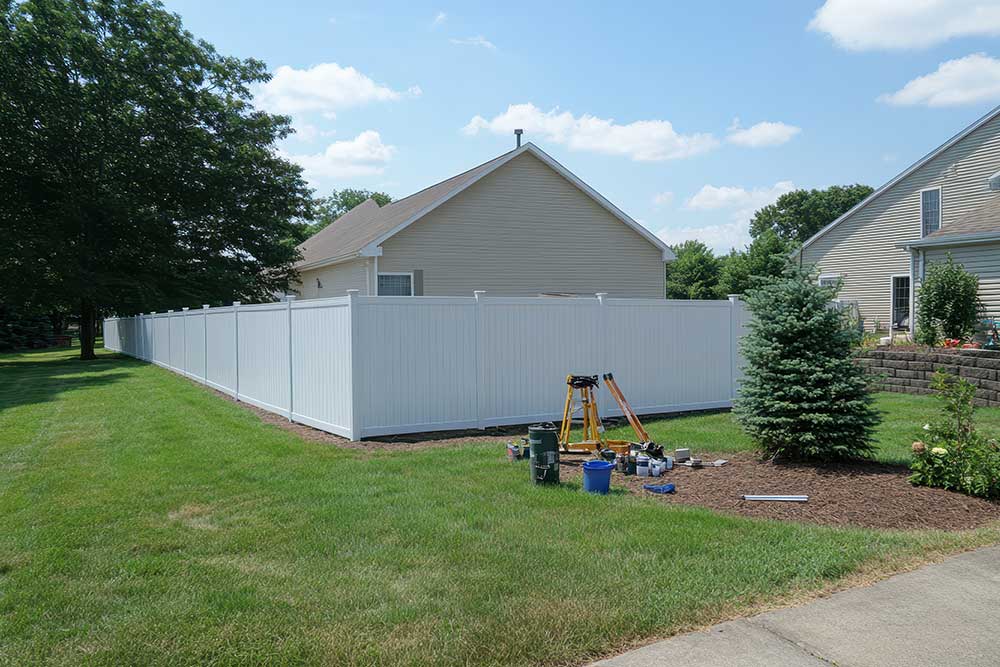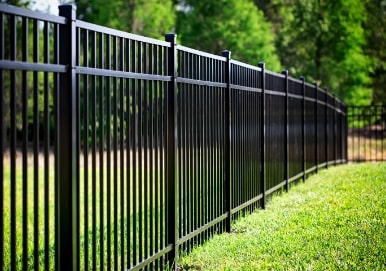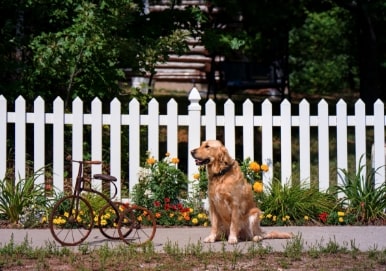Life can be unpredictable, and sometimes your vinyl fence may take a hit. Perhaps a tree branch fell, or a soccer ball from your neighbor’s kid went a bit too far. Or maybe, over time, your fence has developed a cracked or faded panel that’s affecting its appearance.
The good news is that vinyl fence panel replacement isn’t as difficult as it may seem. With the right tools and a bit of guidance, you can replace the damaged section and restore your fence to its former beauty.

Common Reasons for Vinyl Fence Panel Replacement
Damage from Weather and Accidents
Strong winds, heavy storms, and impact from falling branches can crack or dislodge vinyl fence panels. Prolonged exposure to rain, snow, or extreme heat can weaken the structural integrity of the panels. This can lead to warping or brittleness. If a storm has passed, the fence must be inspected for any weak points. Unnoticed damage can worsen over time.
Physical accidents, such as a vehicle backing into the fence or kids playing near it, can also cause cracks. Even small fractures can spread and require complete panel replacement. Keeping an eye on the condition of your fence and addressing minor damages quickly can prevent more extensive repairs in the future.
Wear and Tear Over Time
While vinyl fencing resists rot and insect damage, long-term exposure to the elements can gradually weaken certain areas. UV exposure from the sun may cause fading or slight discoloration, especially if the fence is an older model without UV protection. Over time, small cracks may develop due to temperature fluctuations. This causes the material to expand and contract.
High-traffic areas, where panels are frequently leaned on or brushed against, may develop stress fractures. Regular inspections can help catch minor weaknesses before they turn into major issues. Replacing aging panels prevents further degradation and keeps the fence looking fresh and structurally sound.
Improper Installation or Structural Issues
A poorly installed fence may develop misaligned or loose panels. Incorrect spacing between posts or insufficiently secured panels can result in instability. If the fence was initially installed without reinforcing the posts properly, shifting may occur over time and cause panels to detach or tilt.
When replacing a panel, it is an excellent opportunity to inspect the entire fence structure. Checking the stability of the posts, checking if the horizontal rails are level, and verifying that all connectors are secure can prevent future failures. Addressing underlying issues during replacement enhances the longevity of the entire fence.
Assessing the Damage
Inspecting the Fence
Walking along the fence line and closely examining each panel helps identify damage that may not be immediately visible. Small cracks near the edges of panels or along seams can indicate weakening material. Panels that have become loose or shifted slightly may suggest that the fence posts or rails are also affected.
Look for signs of mold or mildew in shaded areas. These can weaken the vinyl over time. If multiple panels show similar signs of wear, it may be worth considering a larger replacement project instead of a single-panel fix.
Determining the Replacement Method
Vinyl fence panels are typically attached using brackets, interlocking systems, or screws. You should know how the panels are secured before starting the replacement process. Some fences use tongue-and-groove systems where panels slide into place. Meanwhile, others require screws or fasteners to be removed first.
Assessing the attachment type make sure the right approach is taken for removal and replacement. If the panel is part of an interlocking design, extra care must be taken to avoid damaging neighboring panels while sliding the damaged one out.
Gathering the Necessary Materials
Selecting Replacement Panels
Matching the new panels with the existing fence is vital for maintaining a uniform appearance. If the original manufacturer is known, purchasing replacement panels from the same fencing company gives consistency in texture, thickness, and color. In the case when an exact match is unavailable, testing a small sample against the existing fence before purchasing a full set helps avoid noticeable differences.
If the new panel is slightly off in color due to sun fading on older panels, painting or treating all panels with a UV-resistant sealant can create a more cohesive look.
Tools for the Job
The right tools help prevent accidental damage to surrounding fence sections. Gather everything you need for a smooth and efficient repair process. Here’s a breakdown of the key tools and why they matter:
- Drill or Screwdriver: Most vinyl fence panels are secured with screws or brackets. Therefore, you will need a drill (or a good old-fashioned screwdriver) to remove and reattach them. A power drill speeds up the process. However, a manual screwdriver can work for smaller jobs.
- Rubber Mallet: Vinyl is durable but not indestructible. A rubber mallet allows you to tap the new panel into place without cracking or denting it. This can happen if you use a metal hammer.
- Level: Proper alignment is key to keeping your fence looking neat and structurally sound. A level makes sure the new panel sits flush with the surrounding sections. This prevents an uneven or wobbly appearance.
- PVC Adhesive: While not always necessary, PVC adhesive can provide extra stability, particularly in areas prone to strong winds or where reinforcement is needed. If you’re working with interlocking panels, this can help keep them securely in place.
- Tape Measure: Precision matters. Measuring the replacement panel against the existing dimensions gives a perfect fit. Even a slight miscalculation can lead to gaps, misalignment, or unnecessary cutting.
Removing the Damaged Panel
Loosening and Lifting the Panel
Start by carefully removing the top rail if necessary, as this can make it easier to access the damaged panel. If the panel is held by brackets, unscrew or detach them carefully to avoid breaking nearby connections.
For panels that slide into place, gently wiggling the section back and forth helps loosen it without applying excessive force. When a bracket or locking mechanism is preventing easy removal, consulting the manufacturer’s instructions may help prevent damage.
Detaching from Fence Posts
Some panels are secured with hidden fasteners or internal locking systems. In these cases, the neighboring panels may need slight adjustments to create enough space for removal. If screws hold the panel in place, they should be loosened in an even manner to prevent unnecessary stress on one side.
Once detached, inspect the post and rail system for damage. If any parts appear loose or worn, tightening or reinforcing them before installing the new panel offers long-term stability.
Installing the New Panel
Securing the Panel in Place
Positioning the new panel correctly before securing it helps avoid unnecessary adjustments. Sliding it into the designated slot or brackets while keeping it level ensures a proper fit. Does the panel lock into place? Aligning it carefully before securing it prevents misalignment.
Applying gentle pressure with a rubber mallet can help settle the panel without risking cracks. If screws are needed, tightening them evenly prevents uneven pressure. This could lead to stress fractures over time.
Checking Alignment and Stability
Once the panel is secured, stepping back to assess alignment with the rest of the fence gives a seamless fit. Using a level confirms that the new panel sits evenly along the fence line. If minor adjustments are needed, they should be made before securing all fasteners tightly.
If the fence has multiple new panels, check alignment along the entire stretch for uniformity. Making small tweaks during fence installation avoids costly corrections later.
Reinforcing the Fence for Longevity
Preventing Future Damage
Regular inspections help catch minor issues before they require full panel replacements. Keeping the posts sturdy and secure prevents shifting that could lead to misalignment or panel detachment.
Trimming overhanging branches near the fence reduces the risk of storm damage. If the area experiences high winds, reinforcing posts with additional concrete or braces can improve overall durability.
Cleaning and Maintenance
Vinyl fencing requires minimal upkeep. However, routine cleaning helps maintain its appearance and strength. Washing panels with mild soap and water removes dirt buildup. A soft brush or cloth works best for stubborn spots. This will avoid harsh chemicals that may degrade the finish.
Applying a UV-resistant coating can help protect against fading and prolong the life of the fence. Checking connections and brackets periodically means everything stays secure.
Durable Vinyl Fencing for Your Home or Business – Serving Richmond and Beyond
Vinyl fence panel replacement restores both function and visual appeal. Locally owned and operated,Good Neighbor Fence has been serving Richmond, VA, and surrounding areas for over 20 years. Our in-house team specializes in residential and commercial fencing and delivers workmanship warranties for new installations.
We offer a wide variety of vinyl fencing options, including privacy, picket, lattice, and ranch rail panels. All of these choices are designed for durability and style. Our expert installation services guarantee a perfect fit and long-lasting performance. Financing options starting at 0% APR make it easier than ever to restore your fence without breaking the budget.
Call us today at (804) 737-4664 or request a free quote online. Let us help you maintain a strong, long-lasting fence that enhances your property’s curb appeal.





